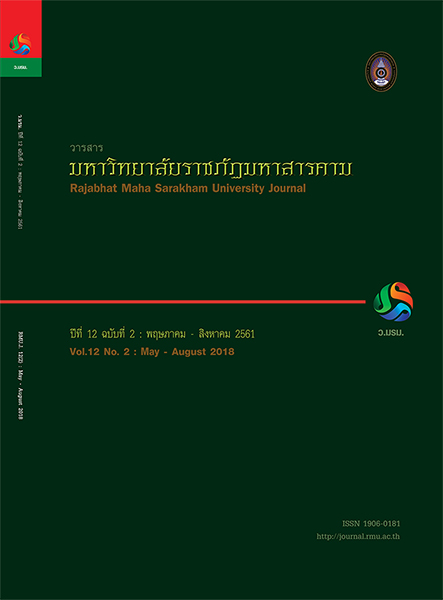การพัฒนารูปแบบการเรียนรู้แบบบูรณาการออนไลน์ตามหลักการสะเต็มศึกษาเพื่อส่งเสริมความสามารถในการคิดวิเคราะห์ของผู้เรียนในระดับมัธยมศึกษา
Main Article Content
บทคัดย่อ
การวิจัยนี้มีวัตถุประสงค์ 1)เพื่อสังเคราะห์และประเมินรูปแบบการเรียนรู้แบบบูรณาการออนไลน์ตามหลักการสะเต็มศึกษา
2) เพื่อส่งเสริมความสามารถในการคิดวิเคราะห์ของผู้เรียนในระดับมัธยมศึกษา กลุ่มตัวอย่างที่ใช้ในการวิจัย ได้แก่ ผู้เชี่ยวชาญในการ
สังเคราะห์รูปแบบ จำนวน 12 คน และผู้ทรงคุณวุฒิในการประเมินรูปแบบ ผลการวิจัยพบว่า องค์ประกอบของรูปแบบที่สังเคราะห์ขึ้น
มี 5 องค์ประกอบ 1) โมดูลคลังความรู้ 2) โมดูลการสอน 3) โมดูลการช่วยเหลือ 4) โมดูลกลยุทธ์การเรียนรู้สะเต็ม และ 5) โมดูล
การประเมินผล โดยมีขั้นตอนการเรียนรู้ 6 ขั้นตอน คือ (1) เตรียมความพร้อม(2) ศึกษาข้อมูล/ปัญหา (3) ตั้งสมมติฐาน (4) ลงมือ
ปฏิบัติ (5) นำเสนอผลงานและ (6) ประเมินผล ซึ่งผลการประเมินความเหมาะสมรูปแบบ พบว่า รูปแบบการเรียนรู้ที่ผู้วิจัยพัฒนาขึ้น
มีความเหมาะสมทั้ง 4 ด้านอยู่ในระดับมาก มีความเหมาะสมของรูปแบบโดยภาพรวมอยู่ในระดับมาก สามารถนำไปใช้เป็นต้นแบบใน
การจัดการเรียนรู้ได้
Article Details
1. บทความที่ลงตีพิมพ์ทุกเรื่องได้รับการตรวจทางวิชาการโดยผู้ประเมินอิสระ ผู้ทรงคุณวุฒิ (Peer Review) สาขาที่เกี่ยวข้อง อย่างน้อย 3 ท่าน ในรูปแบบ Double blind review
2. ข้อคิดเห็นใด ๆ ของบทความที่ลงตีพิมพ์ในวารสารมหาวิทยาลัยราชภัฏมหาสารคาม นี้เป็นของผู้เขียน คณะผู้จัดทำวารสารไม่จำเป็นต้องเห็นด้วย
3. กองบรรณาธิการวารสารมหาวิทยาลัยราชภัฏมหาสารคาม ไม่สงวนสิทธิ์การคัดลอกแต่ให้อ้างอิงแสดงที่มา
เอกสารอ้างอิง
work for 21st Century Learning. Retrieved 20
October 2015, from http://www.p21.org/storage/
documents/P21_Framework_Definitions.pdf.
[2] The Institute for the Promotion of Teaching Science
and Technology (IPST). (2001). Learning
Management Guide, Learning Mathematics Group.
Bangkok : The Institute for the Promotion of
Teaching Science and Technology (IPST).
[3] The Higher Education Commission. (1999).
Guidelines for Higher Education Administration.
Bangkok : The Higher Education Commission.
[4] Ratchanok Sophaphis. (2011). “The Development
of the Experience Readiness Preparation Model
For Tourism Management Students”. Veridian
E-Journal SU, 4(1), May - August 2011, 4-5.
[5] Sitthipon Art-in. (2011). The Development of a
Learning Management Model Emphasizing
Analytical Thinking in the Science Learning Area.
Department of Curriculum and Instruction, Faculty
of Education, Khon Kaen University
[6] Raksapon Thananuwong. (2013). Augmented Reality
Learning Media on the Issue of Sinking and
Floating,” The Institute for the Promotion of
Teaching Science and Technology (IPST),Secondary
Science, IPST Magazine, 41 (181) March-April2013
p. 28-31.
[7] Siriphat Jesadawirot. (2003). Integrated teaching
and learning management. Bangkok : Book Point.
[8] Montree Julawattanathon. (2014). STEM Education
Thailand and STEM Ambassadors. IPST Magazine,
42, (185) : November-December 2013
[9] MonthienThienthong. (2011). Courseware design
and development. Bangkok: Textbook Production
Center, King Mongkut’s Institute of Technology
North Bangkok.
[10] Watts , M.(1991). The Science of Problem -
Solving : A Practical Guide for Science Teachers.
London : Cassell Educational Limited.
[11]Aphisit Thongchai and Others. (2008). Summary of
special lectures on the Issue of Science,
Technology, Engineering, and Mathematics
Education : Preparing students for the 21st
Century. 1 March 2015, from;http://designtechnology.
ipst.ac.th/ uploads/STEMeducation.pdf.
[12] PrachyanunNilsook. (2000). Computer based
simulation (CBS), Journal of Education, Burapa
University, 12(2), 47-51.
[13] Colleen, J. (1996). Designing Web-Based Instruction
: Research and Rationale. (Online) Retrive 12 July
2015, from http://www.cc.utexas.edu/~jonesc/
research/empaper.htm.
[14] The Secretariat of the Council of Education. (2010).
Educational reform proposals in the second
decade. (2009-2018). Bangkok: Secretariat of the
Council of Education.
[15] Withayakorn Chiengkul. (2014). Sweep Thailand :
Another long walk : What, how, to whom, for what
of reform : Sun House.
[16] Ministry of Education. (2009). Core Curriculum
Basic Education 2008 : Office of the Basic
Education Commission. Bangkok : Printing
Agricultural Cooperative Federation of Thailand
Limited.
[17] Nareelak Siriwan. (2016). Integrated Teaching
Across Disciplines (STEM EDUCATION). (Online).
20 April 2016, from :http://library2.parliament.go.th/
giventake/content_royrueng/2016/rr2016-oct1.pdf.
[18] Eisenkraft, Arthur. (2015). Expanding the 5-E Model
a Proposed 7-E Model Exmphasize Transfer of
Learning and the Importance of Eliciting Frior
Understand. The Science Theacher, 70,6 (Jane
2015) : 56-59.
[19] Dejarnette. (2012). America’s children : providingearly
exposure to STEM (science, Technology, Engineering
And Math) Initiatives. Education, 133(1), 77-84.
[20] Bloom,Benjamin S. (1964). Taxonomy of
Educational Objectives : The Classification of
Educational Goals. Handbook ll Affective Domain.
London : Longman,
[21] Porntip Siriphattrachai. (2013). STEM Education
and 21st Century Skills Development. Executive
Journal, 33(2), 49-56.
[22] Chamras Intalapaporn, MarutPatphol, Wichai
Wongyai and SrisamornPumsa-ard. (2015).
“The study guidelinesfor learning management of
the STEM Education for elementarystudents.
Veridian E-Journal, Silpakorn University, 8(1)
January-April 2015.


